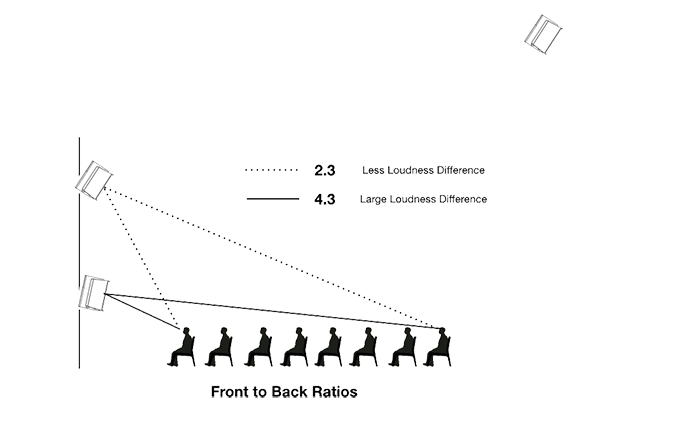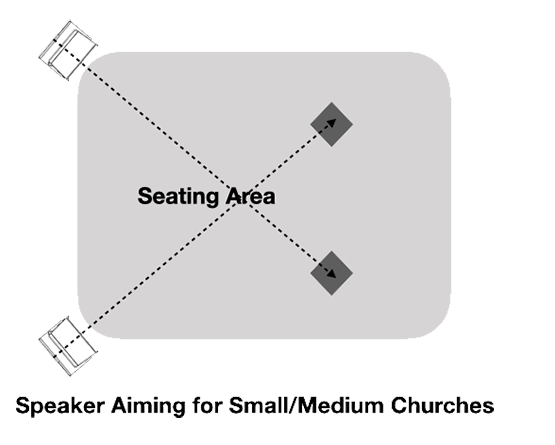
Let the wise also hear and gain in learning.
(Proverbs 1:5a)
By Rev. Paul Wooley
A number of times I have been called to help with church sound systems that were performing poorly. In many cases the most obvious problem was improper positioning of loudspeakers.
Interestingly, many times these were new systems that represented a serious financial investment, and which were installed by alleged experts. More than once, the speakers were not very high and were in fact aimed at the side walls. Luckily these situations were an easy fix, as the speakers merely had to be relocated and properly aimed.
As I stated in a previous article, you are always ‘fighting with’ the acoustics of the room. Improper speaker installation will certainly ‘excite’ the most undesirable acoustic properties, making sound and speech unintelligible.
Following are some basic problems with speaker system placement.
A – No line of sight
If anyone in the congregation cannot see a speaker, they won’t hear it. Remember that we want to hear direct sound and not reflected sound, and since sound doesn’t bend around corners there must be a direct path between the speaker and the ears of the person listening.
B – Speakers are too low
How high should your speakers be? Generally higher than you might think. Often as high as you can get them.
This helps to minimize the difference in sound level between the from and the back of the seating areas.
Sometimes you will find speakers mounted on wall barely above the heads of the congregation. This results in the sound volume being too loud at the front and too soft at the back of the seating area. This is described as the front to back ratio. In a perfect world, the distance between the speaker to the front row and the back row would be the same. But with this concept in mind we can attempt to minimize the difference in these two distances. See figure 1.

Figure 1
C – Speakers not focused for best coverage
One of the most common causes of problems with speech intelligibility is excessive reverb. We can reduce reverb by placing our speakers to focus on the audience and avoid the walls. Stated simply, aim the sound where you need to put it and nowhere else.
Most speaker systems, at lower and midrange (voice) frequency ranges have an approximately conical dispersion pattern of about 90 degrees. In most of our smaller churches, this ends up with a situation where the centreline of the two speaker systems need to be aimed at a point which is on the opposite side of the church around two-thirds of the distance to the rear of the seating area, and roughly one third of the distance from the opposite wall. See figure 2.

Figure 2
D- Speakers placed so that sound doesn’t get into microphones
I would hope that this would be such and obvious problem that it wouldn’t need to be mentioned. We have all been subject to ‘feedback’ caused by this mistake.
Imagine a line across the front of the chancel area, where the microphone positions for the lecture and pulpit are located. Make sure that the speakers are located ahead of that line, in other words between that line and the seating area.
The second consideration is taken care of by the previously mentioned speaker height and focusing. Again the concept is to keep the sound output from causing excessive room reflections and reverberation which leads to feedback.
However, I have seen many instances where speakers had been mounted flat on walls at the front of a church aimed directly at the back wall. The sound bounces between the front and back of the church, then into a microphone to cause either a hollow sound or often ear screeching feed back.
IMPROVING CHURCH SOUND SYSTEMS: BASIC LAYOUT
I CAN'T HEAR THE PREACHER: MICROPHONES
I CAN'T HEAR THE PREACHER: CHURCH ACOUSTICS 1
I CAN'T HEAR THE PREACHER: HEARING THE SPOKEN WORD
POINTERS FOR SPEAKERS AND READERS
Rev. Paul Woolley is a retired priest in Huron. He has 55 years of experience working with audio equipment of every description for varied venues.
(Note: Paul will answer any questions about sound systems in future articles. His email may be found on the Diocese of Huron clergy contact listings.)